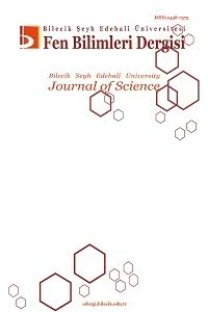Ti(II) Oksit Nanoparçacık Yüklenmiş GMA-co-EGDMA Mikroküreler: Tekstil Boyalarının Sulu Ortamdan Fotokatalitik Giderimi
Ti (II) Oxide Nanoparticle Loaded GMA-co-EGDMA Microspheres: Photocatalytic Removal of Textile Dyes from Aqueous Medium
Heterogeneous Photocatalyst, Polymer, Based Carriers, Nanoparticle, Immobilization Textile Dye Treatment,
___
Borker, P. and A.V. Salker, Photocatalytic degradation of textile azo dye over Ce1−xSnxO2 series. Materials Science and Engineering: B, 2006. 133(1): p. 55-60.Konstantinou, I. and T. Albanis, TiO2-Assisted Photocatalytic Degradation of Azo Dyes in Aqueous Solution: Kinetic and Mechanistic Investigations: A Review. Vol. 49. 2004. 1-14.
H. Ehrampoosh, M., et al., Removal of methylene blue dye from textile simulated sample using tubular reactor and TiO 2/UV-C photocatalytic process. Vol. 8. 2011. 35-40.
Prado, A.G.S., et al., Nb2O5 as efficient and recyclable photocatalyst for indigo carmine degradation. Applied Catalysis B: Environmental, 2008. 82(3): p. 219-224.
Akpan, U.G. and B.H. Hameed, Parameters affecting the photocatalytic degradation of dyes using TiO2-based photocatalysts: a review. J Hazard Mater, 2009. 170(2-3): p. 520-9.
Malato, S., et al., Decontamination and disinfection of water by solar photocatalysis: Recent overview and trends. Catalysis Today, 2009. 147(1): p. 1-59.
Sun, Z., et al., Photocatalytic degradation of a cationic azo dye by TiO2/bentonite nanocomposite. Journal of Photochemistry and Photobiology A: Chemistry, 2002. 149(1): p. 169-174.
Uğurlu, M., Adsorption of a textile dye onto activated sepiolite. Microporous and Mesoporous Materials, 2009. 119(1): p. 276-283.
Kun, R., K. Mogyorósi, and I. Dékány, Synthesis and structural and photocatalytic properties of TiO2/montmorillonite nanocomposites. Applied Clay Science, 2006. 32(1): p. 99-110.
Fukahori, S., et al., Photocatalytic decomposition of bisphenol A in water using composite TiO2-zeolite sheets prepared by a papermaking technique. Environ Sci Technol, 2003. 37(5): p. 1048-51.
Chong, M.N., et al., Recent developments in photocatalytic water treatment technology: a review. Water Res, 2010. 44(10): p. 2997-3027.
Choi, H., E. Stathatos, and D.D. Dionysiou, Photocatalytic TiO2 films and membranes for the development of efficient wastewater treatment and reuse systems. Desalination, 2007. 202(1): p. 199-206.
Molinari, R., et al., Photocatalytic degradation of dyes by using a membrane reactor. Chemical Engineering and Processing: Process Intensification, 2004. 43(9): p. 1103-1114.
Yu, Y., et al., Enhancement of photocatalytic activity of mesoporous TiO2 by using carbon nanotubes. Applied Catalysis A: General, 2005. 289(2): p. 186-196.
Vinodgopal, K., D.E. Wynkoop, and P.V. Kamat, Environmental Photochemistry on Semiconductor Surfaces: Photosensitized Degradation of a Textile Azo Dye, Acid Orange 7, on TiO2 Particles Using Visible Light. Environmental Science & Technology, 1996. 30(5): p. 1660-1666.
Ni, M., et al., A Review and Recent Developments in Photocatalytic Water-Splitting Using TiO2 for Hydrogen Production. Vol. 11. 2007. 401-425.
Litter, M.I., Heterogeneous photocatalysis: Transition metal ions in photocatalytic systems. Applied Catalysis B: Environmental, 1999. 23(2): p. 89-114.
Gelover, S., P. Mondragón, and A. Jiménez, Titanium dioxide sol–gel deposited over glass and its application as a photocatalyst for water decontamination. Journal of Photochemistry and Photobiology A: Chemistry, 2004. 165(1): p. 241-246.
Carpio, E., et al., Photocatalytic degradation of phenol using TiO 2 nanocrystals supported on activated carbon. Vol. 228. 2005. 293-298.
Shironita, S., et al., Preparation of nano-sized platinum metal catalyst using photo-assisted deposition method on mesoporous silica including single-site photocatalyst. Applied Surface Science, 2008. 254(23): p. 7604-7607.
Damodar, R.A. and T. Swaminathan, Performance evaluation of a continuous flow immobilized rotating tube photocatalytic reactor (IRTPR) immobilized with TiO2 catalyst for azo dye degradation. Chemical Engineering Journal, 2008. 144(1): p. 59-66.
Shan, A.Y., T.I.M. Ghazi, and S.A. Rashid, Immobilisation of titanium dioxide onto supporting materials in heterogeneous photocatalysis: A review. Applied Catalysis A: General, 2010. 389(1): p. 1-8.
Li, Y. and S.-J. Kim, Synthesis and Characterization of Nano titania Particles Embedded in Mesoporous Silica with Both High Photocatalytic Activity and Adsorption Capability. The Journal of Physical Chemistry B, 2005. 109(25): p. 12309-12315.
Fabiyi, M. and R. L Skelton, Photocatalytic Mineralisation of Methylene Blue using Buoyant TiO2-Coated Polystyrene Beads. Vol. 132. 2000. 121-128.
Mahshid, S., M. Askari, and M. Sasani Ghamsari, Synthesis of TiO2 Nanoparticles by Hydrolysis and Peptization of Titanium Isopropoxide Solution. Vol. 189. 2007. 296-300.
Xiong, Z., et al., Synthesis of TiO2 with controllable ratio of anatase to rutile. Journal of Materials Chemistry A, 2014. 2(24): p. 9291-9297.
- Yayın Aralığı: 2
- Başlangıç: 2014
- Yayıncı: BİLECİK ŞEYH EDEBALİ ÜNİVERSİTESİ
Farklı Akım Koşullarına Sahip Serbest Hidrolik Sıçramanın Deneysel ve Sayısal Modellemesi
Veysel GÜMÜŞ, Mehmet PARMAKSIZ, Oğuz ŞİMŞEK, Yavuz AVŞAROĞLU
Kübra TURAN, Rukiye SAYGILI CANLIDİNÇ, Orhan Murat KALFA
POLYMERIC INSULATOR PERFORMANCE TEST UNDER MAGNETIC FIELD EFFECT
Fatih ATALAR, Doğan TÜRKAY, Arif YILDIRIMÇAKAR, Aysel ERSOY YILMAZ, Mukden UĞUR
Melas veya Arpa Kırması İlavesinin Börülce ve Soya Silajlarının Kalitesi Üzerine Etkisi
Erdem GÜLÜMSER, Hanife MUT, Uğur BAŞARAN, Medine ÇOPUR DOĞRUSÖZ
3 Boyutlu Lorentz Uzayında Null Cartan Helisler: Bir Yaklaşım
Ellajik Asidin İnsan Akciğer Kanseri Üzerine Antiproliferatif Etkinliklerinin İn Vitro Araştırılması
Emre ÇÖMLEKÇİ, Canan VEJSELOVA SEZER, Hüseyin İZGÖRDÜ, Mehtap KUTLU
Hilal MEDETALİBEYOĞLU, Haydar YÜKSEK
Endüstriyel Kazanlarda Yanma Veriminin Süreç Geliştirme Teknikleri Kullanılarak İyileştirilmesi
